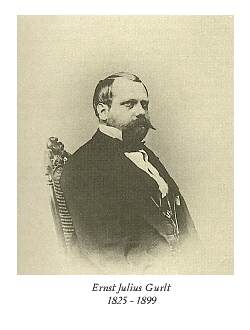Ernst Julius Gurlt
Ernst Julius Gurlt (13 October 1825 – 8 August 1899) was a notable German veterinarian and anatomist. He made significant contributions to the field of veterinary medicine and was a prominent figure in the development of comparative anatomy.
Early Life and Education[edit | edit source]
Ernst Julius Gurlt was born in Berlin, Kingdom of Prussia. He was the son of the renowned surgeon and anatomist Ernst Friedrich Gurlt. Following in his father's footsteps, Gurlt pursued a career in medicine and veterinary science. He studied at the University of Berlin, where he was influenced by leading scientists of the time.
Career[edit | edit source]
Gurlt's career was marked by his dedication to the advancement of veterinary medicine. He held various academic positions and was a professor at the Royal Veterinary School in Berlin. His work primarily focused on comparative anatomy, where he compared the anatomical structures of different animal species to understand their functions and evolutionary relationships.
Contributions to Veterinary Medicine[edit | edit source]
Gurlt made several important contributions to veterinary science, including:
- Development of new surgical techniques for animals.
- Research on the anatomy and physiology of domestic animals.
- Publications on veterinary pathology and surgery.
His work laid the foundation for modern veterinary practices and influenced future generations of veterinarians.
Publications[edit | edit source]
Gurlt authored numerous scientific papers and books on veterinary medicine and anatomy. Some of his notable works include:
- Handbuch der vergleichenden Anatomie der Haussäugetiere (Handbook of Comparative Anatomy of Domestic Mammals)
- Lehrbuch der Chirurgie und Augenheilkunde für Tierärzte (Textbook of Surgery and Ophthalmology for Veterinarians)
Legacy[edit | edit source]
Ernst Julius Gurlt is remembered as a pioneer in veterinary medicine. His contributions to the field have had a lasting impact, and his work continues to be referenced by veterinarians and researchers.
Related Pages[edit | edit source]
- Veterinary medicine
- Comparative anatomy
- Ernst Friedrich Gurlt
- University of Berlin
- Royal Veterinary School
Categories[edit | edit source]
Search WikiMD
Ad.Tired of being Overweight? Try W8MD's physician weight loss program.
Semaglutide (Ozempic / Wegovy and Tirzepatide (Mounjaro / Zepbound) available.
Advertise on WikiMD
|
WikiMD's Wellness Encyclopedia |
| Let Food Be Thy Medicine Medicine Thy Food - Hippocrates |
Translate this page: - East Asian
中文,
日本,
한국어,
South Asian
हिन्दी,
தமிழ்,
తెలుగు,
Urdu,
ಕನ್ನಡ,
Southeast Asian
Indonesian,
Vietnamese,
Thai,
မြန်မာဘာသာ,
বাংলা
European
español,
Deutsch,
français,
Greek,
português do Brasil,
polski,
română,
русский,
Nederlands,
norsk,
svenska,
suomi,
Italian
Middle Eastern & African
عربى,
Turkish,
Persian,
Hebrew,
Afrikaans,
isiZulu,
Kiswahili,
Other
Bulgarian,
Hungarian,
Czech,
Swedish,
മലയാളം,
मराठी,
ਪੰਜਾਬੀ,
ગુજરાતી,
Portuguese,
Ukrainian
Medical Disclaimer: WikiMD is not a substitute for professional medical advice. The information on WikiMD is provided as an information resource only, may be incorrect, outdated or misleading, and is not to be used or relied on for any diagnostic or treatment purposes. Please consult your health care provider before making any healthcare decisions or for guidance about a specific medical condition. WikiMD expressly disclaims responsibility, and shall have no liability, for any damages, loss, injury, or liability whatsoever suffered as a result of your reliance on the information contained in this site. By visiting this site you agree to the foregoing terms and conditions, which may from time to time be changed or supplemented by WikiMD. If you do not agree to the foregoing terms and conditions, you should not enter or use this site. See full disclaimer.
Credits:Most images are courtesy of Wikimedia commons, and templates Wikipedia, licensed under CC BY SA or similar.
Contributors: Prab R. Tumpati, MD

